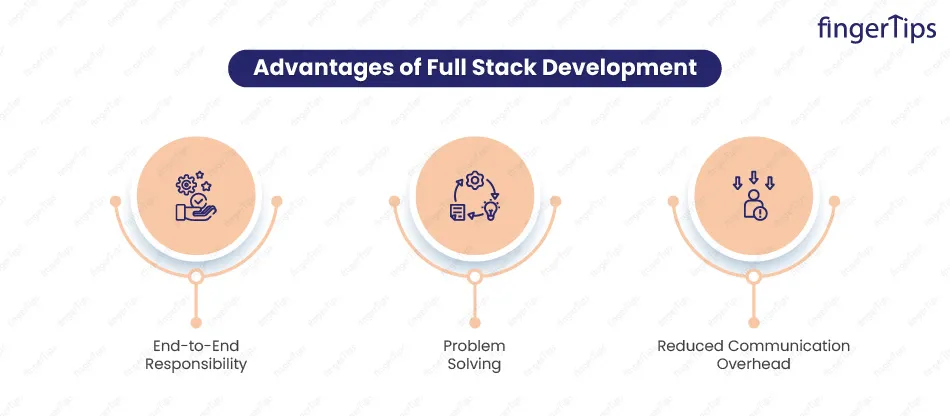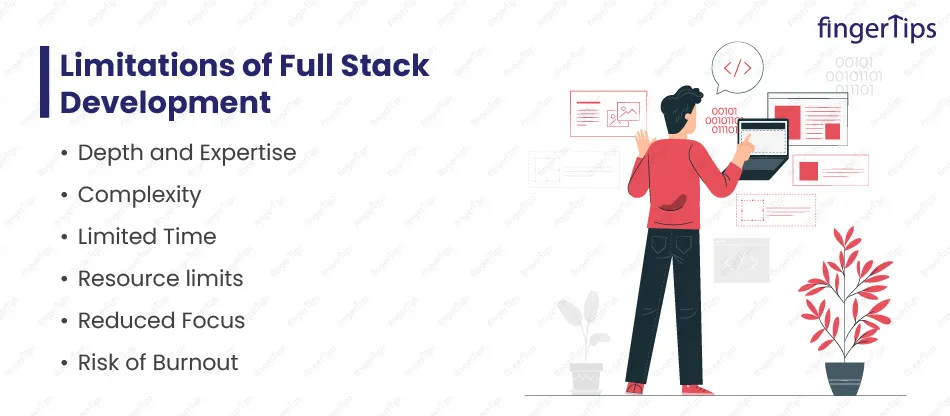If you're from a coding background or are willing to start a career as one, you've probably heard the term full stack web developer many times. These professionals work on front-end and back-end parts of websites or software applications. Does this interest you? Or are you willing to know more about full-stack development? Keep reading, and you'll get all the necessary information by the end of this guide.
To understand everything from basic, let's see what client software (Front End part of the website) is.
Client Software (Front End)

Modern computing systems must include client software, commonly called front-end software. It describes the programs and user interfaces that consumers use directly. This software is vital to the user experience because it presents data and allows user interactions.
Web browsers, mobile apps, desktop applications, and other types are all examples of front-end software. These programs use graphical features, buttons, and menus for simple navigation and are made to be intuitive to use and aesthetically pleasing. They let users view and modify information kept on servers or distant databases.
Being able to communicate with server-side software, like databases or web servers, using protocols like HTTP or WebSocket is a crucial feature of client software. This makes data retrieval and real-time changes possible, guaranteeing that consumers have access to the most recent information. Now, let's see what is server software (Back End) in full-stack development.
Server Software (Back End)
An essential part of computing infrastructure is server software, also called back-end software, which works in the background to support and manage data and services. It is the foundation of applications and systems, processing requests, managing databases, and assuring an application's usability and security.
Data storage and retrieval, user identification, and the execution of business logic are just a few of the crucial tasks that back-end software handles. It frequently interacts with databases and manages data systematically and effectively, ensuring that applications can reliably store and access data.
The processing of client requests is one of the main functions of server software. A client application, such as a website or mobile app, sends requests to the server whenever a user interacts with it. After processing these requests, the server responds with replies often sent back in HTML, JSON, or XML, carrying out the necessary calculations and retrieving data from databases.
Now that you know client and server software well, let's see some of the popular stacks.
Popular Stacks

A "stack" is the collection of technologies, languages, libraries, and tools that are employed in full-stack development to create both the front-end (client-side) and back-end (server-side) components of a web application or software system. The ability to interact with the entire stack allows full-stack engineers to manage both the client-side and server-side functionality.
MEAN Stack
MEAN stack stands for MongoDB, Express.js, Angular, Node.js. JavaScript is used for both front-end and back-end development in the MEAN Stack, which offers a unified development environment and makes code sharing between the client and server easier. This stack's ability to effectively manage asynchronous processes makes it particularly well-liked for developing single-page applications (SPAs) and real-time online applications.
MERN Stack
Here MERN stack stands for MongoDB, Express.js, React, and Node.js. JavaScript is used for both front-end and back-end development in the MERN Stack, offering a seamless working environment. Due to its effectiveness in handling delayed tasks, this stack is particularly well-liked for building single-page applications (SPAs) and real-time online applications.
LAMP Stack
LAMP stack stands for Linux, Apache, MySQL, and PHP. The LAMP Stack is recognized for its affordability and simplicity, making it a great option for various online applications, from little personal websites to expansive enterprise solutions. The open-source nature of LAMP, as well as the abundance of tools and community support, have all led to its lasting success in the web development industry.
Django Stack
Although it is not a widely used industry term, "Django Stack" might refer to a full-stack development configuration built around the Django web framework. A high-level, open-source Python web framework called Django is renowned for its effectiveness, scalability, and capacity for quick development. A web application's front-end and back-end components are often created when using Django.
Now, let's see some advantages and disadvantages of full stack development.
Advantages of Full Stack Development

Full-stack development, where a developer is knowledgeable in both front-end and back-end technologies, has several benefits that help to facilitate the efficient, streamlined, and thorough development of applications.
End-to-End Responsibility: The ability to take control of the complete development process is one of the main benefits of full-stack development. Full-stack developers can manage database administration and server logic in addition to building user interfaces. Greater control over the project's architecture, design, and functionality is possible thanks to this end-to-end responsibility.
Efficiency and quicker iterations are possible with full-stack developers because they can work on both front-end and back-end components. As a result, iterations and development cycles go more quickly because there is no requirement for handoffs between various specialized teams. More quickly implemented changes and updates ensure quicker answers to customer input and market demands.
Problem-Solving: Full-stack developers are well-versed in every aspect of the software stack. This makes it possible for them to recognize and handle problems that may affect many application layers, from UI responsiveness to database optimization. Their integrated approach to problem-solving reduces coordination issues and yields more effective answers.
Reduced Communication Overhead: In traditional development workflows, front-end and back-end teams frequently communicate extensively to agree on requirements and implementation specifics. Full-stack developers may easily bridge both sides, eliminating this communication overhead. As a result, communication runs more smoothly; there are fewer misunderstandings and better project coordination.
Become A Full Stack Developer In 6 Months ,Pay When You Get Hired-Enroll Now
To keep up with the quickly changing technology world, developers aspiring to become full-stack experts must regularly update their abilities.
Limitations of Full Stack Development

Developers seeking to become full-stack experts must continually refresh their skills to keep up with the rapidly evolving technology industry.
Depth and Expertise: Full-stack engineers are expected to understand both front-end and back-end technologies deeply. However, attaining expertise in both domains can be challenging. Often, honing skills in one area might come at the cost of another. Developers focusing on either the front-end or the back-end, who have specialized knowledge, may exhibit greater proficiency in their respective fields.
Complexity: Due to the variety of technologies and tools used, full-stack development can be challenging. In particular, managing both front-end and back-end components, databases, and server configurations can be burdensome for newcomers or large-scale projects.
Limited Time: One major drawback of the constantly changing front-end and back-end technology landscape is the time needed to keep up with it. Full-stack developers must devote time to ongoing learning, which may reduce the amount of time they have for actual development work.
Resource limits: Relying only on full-stack developers can limit resources in larger organizations or projects with significant requirements. Without specialized specialists on the team, specialized activities like difficult database optimization or elaborate UI/UX design may produce less-than-ideal results.
Reduced Focus: Full-stack developers frequently juggle several obligations and duties. This might result in a loss of focus on a particular area, leading to inferior code quality, ineffective algorithms, or poor user experiences compared to what experts might do.
Risk of Burnout: Full-stack developers may face a heavy workload and high expectations. If not properly handled, juggling front-end and back-end development, problem-solving, and being current with technological improvements can result in burnout.
Conclusion
In summary, full-stack development allows developers to work on a project's front-end and back-end components, making it a flexible and all-encompassing method for creating web applications. Being a "jack of all trades" in the field of software development is embodied by it.
The decision to pursue a career in full-stack development or hire full-stack developers for a project ultimately depends on the particular requirements and objectives of the project or organization. Understanding the benefits and drawbacks of full-stack development is essential for making well-informed decisions in the always-changing field of web development, whether you're a developer trying to diversify your skill set or a company looking to maximize your development team.







